CKBlog: The Market
Friday, October 21, 2022
2022: An Unprecedented Year (thus far)
by The CastleKeep Team
In this letter, we will address the following:
- Why 2022 has been unprecedented for diversified portfolios.
- Why going to cash entering 2022 may have been profitable in the short-run (with the benefit of hindsight today) but costly in the long-run.
- Why long-term investors should not convert their portfolios to cash today.
- Highlight tactical moves during the market sell-off.
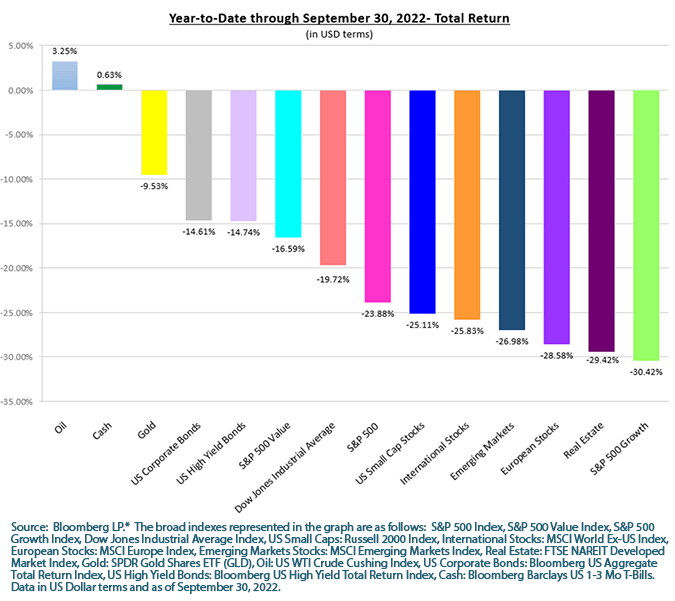
As you can see in the chart above, investors virtually had nowhere to hide through the first three quarters of 2022. With the exception of oil and cash, all major asset classes have suffered losses. If you own a portfolio of stocks and bonds (or just about anything else), it has been a painful year.
Drilling down to the sector level, pain was also widespread as depicted in the following chart.
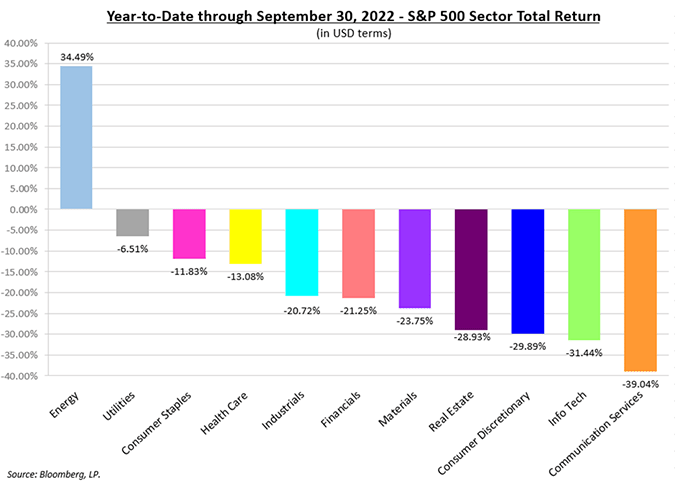
In fact, a traditional 60/40 portfolio (made up of 60% US total stock market index and 40% 10-Year US Treasury notes) was down roughly 20% through October 7th. This has been, by far, the worst calendar year return for diversified stock and bond portfolios since 1980. The chart below demonstrates just how unique this year has been.
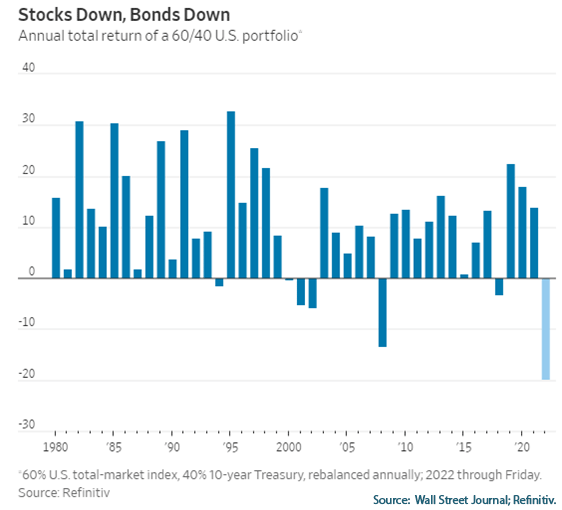
While most stock investors should be accustomed to volatile years, bond investors ... not so much. Normally, when stocks suffer major selloffs, investors turn to bonds for shelter during the storm. An increase in demand for bonds drives their prices higher, thereby supporting a diversified portfolio. But that hasn’t been the case this year. As interest rates have moved higher, bond prices have moved lower—a lot lower. The graph below depicts the performance each year for the Bloomberg US Aggregate Index since 1970. The bold blue line is 2022 through September 30th. Bond investors have never experienced anything like this before.
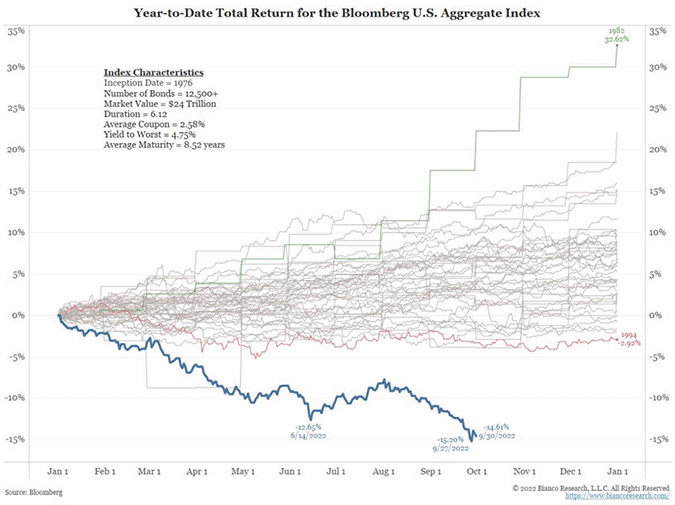
Most market participants attribute the sell-off to actions and signals by global central banks. To combat inflation, most central banks have been aggressively raising their benchmark interest rates. As rates rise, economies typically slow down (due to higher borrowing costs) and capital markets become skittish. Cash and short-term bonds will offer juicier yields over time and may become attractive alternatives compared to stocks. It can be a vicious cycle.
Why We Didn’t Recommend Going to Cash in Early 2022
To be clear, the majority of portfolios we manage carry long-term mandates, so for this letter we will focus on this cohort. Over the long-term (think 10+ years), stocks have proven to offer the most attractive returns compared to bonds and cash. So, naturally, the bias should be towards stocks (again, for long-term objectives). The graph below from the Credit Suisse Global Investment Returns Yearbook for 2022 depicts the returns for US stocks, US bonds, and US T-bills adjusted for inflation. Stocks offer investors the best return over time and have outpaced inflation by 6.7% per year since 1900.
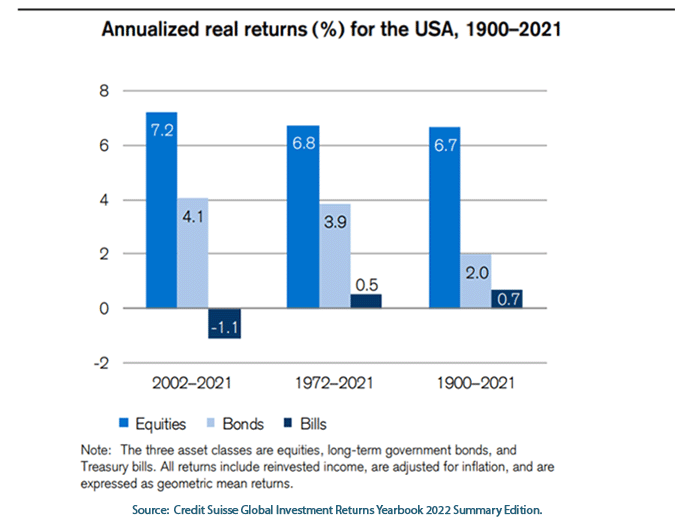
Just because stocks have offered higher returns in the past does not guarantee anything in the future. There are certainly periods throughout the economic and market cycles where stocks are inferior investment options. It seems that we are in the midst of one of those times, driven largely by the rise in global interest rates which has deflated the speculative bubble caused by prolonged excessively low rates.
The US Federal Reserve began signaling in late 2021 that they would raise interest rates and apply quantitative tightening measures to try to tame inflation. So why wasn’t that a signal to go to cash?
First, the Fed had just spent months telling the world that inflation was transitory. Just when it seemed they would never change their stance, they pivoted. When they began to take inflation more seriously, they gave no indication of how much they would raise rates nor for how long. What if one or two hikes tamed inflation? They had just pivoted from their “transitory” stance so what was preventing them from yet again altering their plan? What would equity and bond markets have done if they pivoted earlier on?
While it is impossible to know precisely, we do have the fourth quarter of 2018 as an analogue. In mid to late 2018 a newly appointed Fed Chairman, Jerome Powell, and his board began hiking interest rates to combat their concern about the US economy overheating (which usually results in elevated inflation). The stock market sold-off nearly 20% in a matter of weeks by year-end as it became clear the Fed was not backing down. By early 2019, however, Powell and the Fed pivoted and actually lowered rates as described in the following excerpt from an article in the Washington Post:
By Jan. 4, Powell had a different message, effectively admitting the December 2018 rate hike was a miscalculation. The Fed, he said, would “patient” on rate hikes because there was little sign of an inflationary spike. By March, the Fed announced a plan to stop selling off the assets it purchased in the aftermath of the Great Recession, another sign the Fed was taking its foot off the brakes.
In July, the Fed made its first rate cut in more than a decade, as it became more likely that the economy needed stimulus, not restraint.
(Source: Article “2019: The year the Federal Reserve admitted it was wrong”, December 11, 2019; The Washington Post.)
What did the S&P 500 Index do during that period?
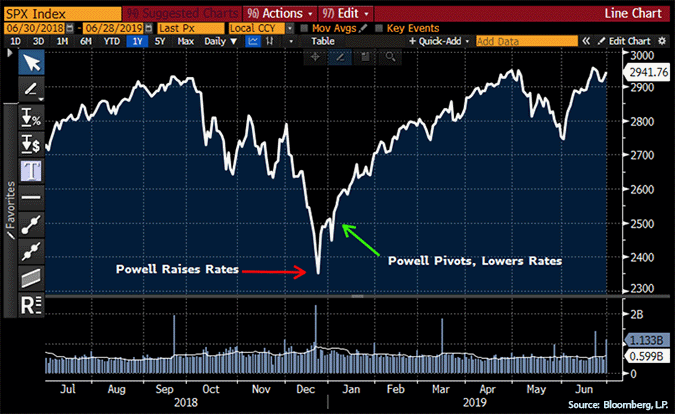
Consider those that sold out of stocks in December of 2018 when Powell indicated more rate hikes were on the way? By the time Powell pivoted, the markets were already in full rebound mode. How long might those investors who sat in cash have waited for the “all clear” signal to get back in? Imagine how costly that was for some as markets continued to rally?
Cash? Now?
We understand investors are concerned that the Fed will continue to increase rates. We also understand that may cause folks to question whether it would be better to go to cash today and wait for the “all clear” signal. Unless you have a short-term need for these funds, we do not recommend this. Why?
First of all, selling today would guarantee to lock in today’s prices for stocks and bonds after they have already sold-off. The yield earned on cash and short-term US Treasury bills may be higher today than in the past, but it will still take years to recover 2022 losses if the securities were sold today.
Second, the market normally bottoms when investors least expect it. We witnessed this during the Global Financial Crisis and wrote about it back in 2020 when investors faced a similar dilemma. You can read the full post The Most Common Question here, but we’ll highlight the following excerpt:
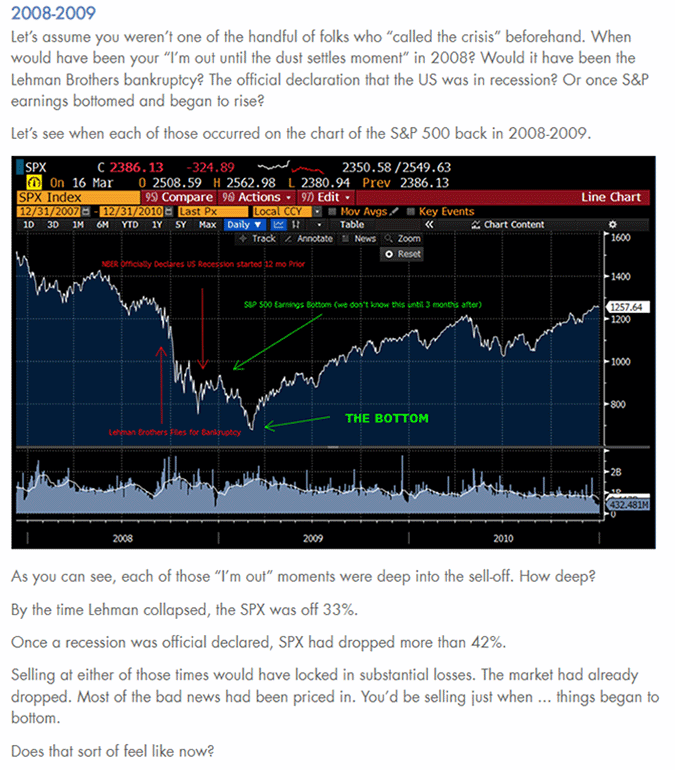
We wrote that piece on March 13th, 2020. The market bottomed 10 days later.
We don’t have the ability to accurately predict when markets will top or bottom. The reality is no one does. Those who claim to have sold out prior to this sell-off will only be “right” if they also pick the right time to get back in. Just as it’s hard to sell out when things are rosy, it becomes nearly impossible for folks to buy back in at the bottom because it usually takes place when pessimism is at its peak—when people are most afraid.
Lastly, successful market timing only becomes obvious in hindsight. You may have gone into cash prior to the Global Financial Crisis (GFC) but was it obvious to jump back in during March 2009 when the world was still reeling? There was great skepticism about the rally for years after the GFC all while the S&P 500 Index delivered an average return over 16% per year for the subsequent ten years.
You may have correctly sold out in the early reporting of COVID but was it obvious to buy in March 2020 on the heels of over three million jobs being lost in one week due to a global economic shutdown? By August of that year, the market fully recovered from its lows. Even after this current sell-off, the S&P 500 Index still trades higher than the days COVID first hit our shores.
If markets have further to fall today, there is no guarantee that the average investor will have the skill and courage (or luck) to buy on the dips in this volatile market. The market will recover. That’s what markets have done after previous major drawdowns similar to what we’ve experienced today. In fact, as Ben Carlson of Ritholtz Wealth Management demonstrated in his blog post (site referenced below), the returns after an S&P 500 Index drawdown of 25% or more have been particularly impressive.
You can’t enjoy the green without being willing to experience the red.
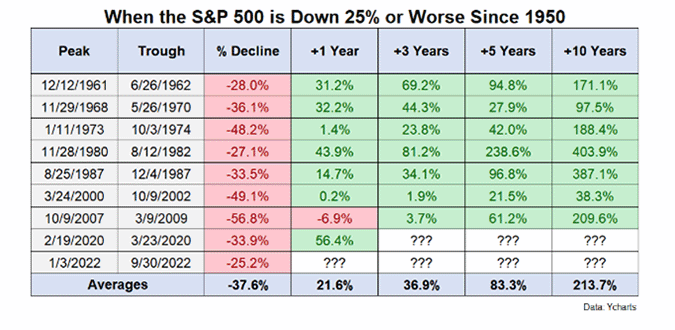
Source: Ycharts; “Animal Spirits: Long-Term Bullish” post on A Wealth of Common Sense.
Remember that past performance is no guarantee of future results. This time, indeed, may be different. But history tells us the odds are in the investors’ favor when sticking with stocks over time.
Tactical Moves in 2022
We didn’t go to all cash. And we still wouldn’t recommend it today (again, for investors with long-term objectives). But that doesn’t mean we did not make tactical changes during the year. While each client’s situation is unique, below are examples of tactical moves we made for discretionary clients in general:
- Multiple rebalances where, in general, we sold portions of securities that had done relatively well (bank stocks, dividend growing stocks) and purchased more of what we believed to be greatly undervalued (non-US stocks).
- We remained underweight growth stock strategies. We believe the so-called growth stock darlings from 2010-2020 were and are still overvalued. The S&P 500 Growth Index is down 30.42% including dividends this year through September 30th. The S&P 500 Value Index, by contrast, was down 16.59% including dividends over the same period.
- We converted traditional, core fixed income exposure to Business Development Companies (BDCs) that issue and hold floating rate loans to middle market companies. In general, these BDCs trade below their Net Asset Values (NAV) and have dividend yields between 8%-12% per annum. Investors can buy these companies for less than the value of their underlying loans and be paid relatively high yields to stick with the company as they navigate and manage their portfolios in these market conditions. Since the loans these companies own carry floating interest rates, if rates continue to rise, so too will the interest they collect from the companies they lend to (provided the underlying companies remain solvent of course).
- We exited longer duration bond funds, which tend to suffer more than short duration bond funds when interest rates move higher. Besides BDCs, we got back into other strategies or ETFs investing in floating rate loans (i.e., bank loans). For reference, the iShares 20+ Year US Treasury Bond ETF was down 29.92% including interest this year through September 30th. That is a remarkable drawdown for a bond fund that typically has been viewed as a safe haven during periods of equity volatility.
Zoom Out
Humans evolve in part by focusing on the now, especially in times of danger. When a bear is charging at you, it’s best to focus all your energy on surviving the attack—patience is no defense. Sophisticated investing throughout market cycles requires the opposite—patience is rewarded.
So during bear markets, resist your innate response. Rather than focus on the day-to-day news cycle, zoom out to remind yourself why it’s a good idea to invest in stocks (and bonds) in the first place. As the chart below from JP Morgan demonstrates, returns over one-year periods for stocks can be ugly, including down 39% in 2008. But as you zoom out, drawdowns improve. Over all 20-year rolling periods since 1950, the worst annual return stocks delivered was an increase of 6% per year.
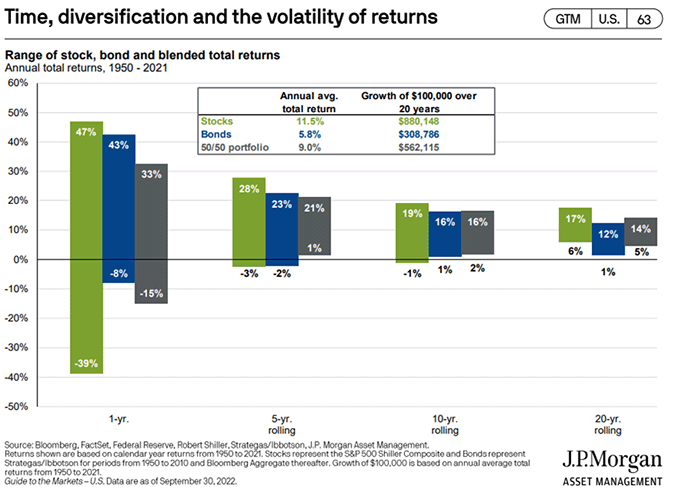
We understand this year has been difficult because we, too, have endured the pain. However, our experience gives us the conviction that staying the course remains the best plan of action during these times. CastleKeep has been advising clients for over 20 years. We remember many times like these, where it seems as if the stock market will not recover and without fail, the market has recovered each time. Not only has it recovered but it continually set new all-time highs.
We don’t know when it will happen this time, but it will—probably when we least expect it. We recommend you hold on but we also realize this may require some additional hand holding. If you would like to discuss this letter or your portfolio in detail, we are always available and are here to help. As always, we are thankful for your trust and confidence.
Sincerely,
The CastleKeep Team
Click to download a PDF of this entry.




